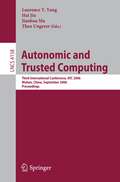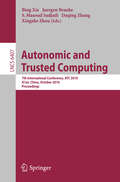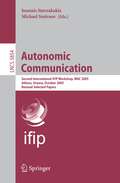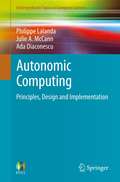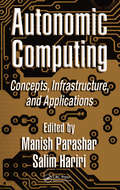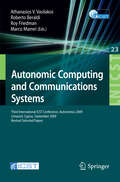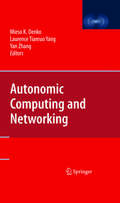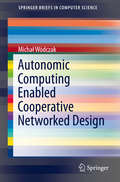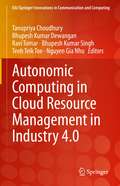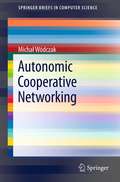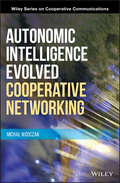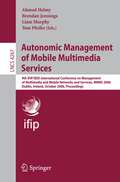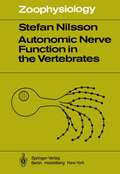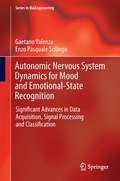- Table View
- List View
Autonomic and Trusted Computing: Third International Conference, ATC 2006, Wuhan, China, September 3-6, 2006 (Lecture Notes in Computer Science #4158)
by Laurence T. Yang Hai Jin Theo UngererThis book constitutes the refereed proceedings of the Third International Conference on Autonomic and Trusted Computing, ATC 2006, held in Wuhan, China in September 2006. The 57 revised full papers presented together with two keynotes were carefully reviewed and selected from 208 submissions. The papers are organized in topical sections.
Autonomic and Trusted Computing: 7th International Conference, ATC 2010, Xi'an, China, October 26-29, 2010, Proceedings (Lecture Notes in Computer Science #6407)
by DaQing Zhang Xingshe Zhou Bing Xie Juergen Branke S. Masoud SadjadiComputing systems including hardware, software, communication, and networks are becoming increasingly large and heterogeneous. In short, they have become - creasingly complex. Such complexity is getting even more critical with the ubiquitous permeation of embedded devices and other pervasive systems. To cope with the growing and ubiquitous complexity, autonomic computing (AC) focuses on self-manageable computing and communication systems that exhibit self-awareness, self-configuration, self-optimization, self-healing, self-protection and other self-* properties to the maximum extent possible without human intervention or guidance. Organic computing (OC) additionally addresses adaptability, robustness, and c- trolled emergence as well as nature-inspired concepts for self-organization. Any autonomic or organic system must be trustworthy to avoid the risk of losing control and retain confidence that the system will not fail. Trust and/or distrust relationships in the Internet and in pervasive infrastructures are key factors to enable dynamic interaction and cooperation of various users, systems, and services. Trusted/ trustworthy computing (TC) aims at making computing and communication systems––as well as services––available, predictable, traceable, controllable, asse- able, sustainable, dependable, persistent, security/privacy protectable, etc. A series of grand challenges exists to achieve practical autonomic or organic s- tems with truly trustworthy services. Started in 2005, ATC conferences have been held at Nagasaki (Japan), Vienna (Austria), Three Gorges (China), Hong Kong (China), Oslo (Norway) and Brisbane (Australia). The 2010 proceedings contain the papers presented at the 7th International Conference on Autonomic and Trusted Computing (ATC 2010), held in Xi’an, China, October 26–29, 2010.
Autonomic Communication (Lecture Notes In Physics #Vol. 51)
by Stamatis Karnouskos Manish Parashar Witold Pedrycz Athanasios V. VasilakosNew paradigms for communication/networking systems are needed in order to tackle the emerging issues such as heterogeneity, complexity and management of evolvable infrastructures. In order to realize such advanced systems, approaches should become task- and knowledge-driven, enabling a service-oriented, requirement, and trust-driven development of communication networks. The networking and seamless integration of concepts, technologies and devices in a dynamically changing environment poses many challenges to the research community, including interoperability, programmability, management, openness, reliability, performance, context awareness, intelligence, autonomy, security, privacy, safety, and semantics. This edited volume explores the challenges of technologies to realize the vision where devices and applications seamlessly interconnect, intelligently cooperate, and autonomously manage themselves, and as a result, the borders of virtual and real world vanish or become significantly blurred.
Autonomic Communication: First International IFIP Workshop, WAC 2004, Berlin, Germany, October 18-19, 2004, Revised Selected Papers (Lecture Notes in Computer Science #3457)
by Michael SmirnovThe ?rst IFIP Workshop on Autonomic Communication (WAC 2004) was held 18–19 October 2004 in Berlin, Germany. The workshop was organized by Fra- hofer FOKUS with the help of partners of the EU-funded Autonomic Com- nication Coordination Action — IST-6475 (ACCA), and under technical sp- sorship of IFIP WG6. 6 — Management of Networks and Distributed Systems. The purpose of this workshop was to discuss Autonomic Communication—a new communication paradigm to assist the design of the next-generation n- works. WAC 2004 was explicitly focused on the principles that help to achieve purposeful behavior on top of self-organization (self-management, self-healing, self-awareness, etc. ). The workshop intended to derive these common principles from submissions that study network element’s autonomic behavior exposed by innovative (cross-layer optimized, context-aware, and securely programmable) protocol stack (or its middleware emulations) in its interaction with numerous, often dynamic network groups and communities. The goals were to understand how autonomic behaviors are learned, in?uenced or changed, and how, in turn, these a?ect other elements, groups and the network. The highly interactive and exploratory nature of WAC 2004 de?ned its format — six main sessions grouped in three blocks, each block followed by a panel with all speakers of the previous block as panellists and session chairs as panel moderators. The?rstpanelaimedtohighlightthemainprinciplesguidingresearchinal- rithms,protocolsandmiddleware;thesecondpanelinvestigatedgrandchallenges of network and service composition; the third panel had to answer the question “HowDoestheAutonomicNetworkInteractwiththeKnowledgePlane?”. Panel reports were compiled by panel moderators and conclude this volume.
Autonomic Communication: Second International IFIP Workshop, WAC 2005, Athens, Greece, October 2-5, 2005, Revised Selected Papers (Lecture Notes in Computer Science #3854)
by Ioannis Stavrakakis Michael SmirnovThis book constitutes the thoroughly refereed post-proceedings of the Second International IFIP Workshop on Autonomic Communication, WAC 2005, held in Athens, Greece in October 2005. The 22 revised full papers presented together with one keynote paper, three invited papers and two panel summaries were carefully selected during two rounds of reviewing and improvement from numerous submissions. The papers discuss the principles of Autonomic Communication (AC).
Autonomic Computing: Principles, Design and Implementation (Undergraduate Topics in Computer Science)
by Philippe Lalanda Julie A. McCann Ada DiaconescuThis textbook provides a practical perspective on autonomic computing. Through the combined use of examples and hands-on projects, the book enables the reader to rapidly gain an understanding of the theories, models, design principles and challenges of this subject while building upon their current knowledge. Features: provides a structured and comprehensive introduction to autonomic computing with a software engineering perspective; supported by a downloadable learning environment and source code that allows students to develop, execute, and test autonomic applications at an associated website; presents the latest information on techniques implementing self-monitoring, self-knowledge, decision-making and self-adaptation; discusses the challenges to evaluating an autonomic system, aiding the reader in designing tests and metrics that can be used to compare systems; reviews the most relevant sources of inspiration for autonomic computing, with pointers towards more extensive specialty literature.
Autonomic Computing: Concepts, Infrastructure, and Applications
by Manish Parashar and Salim HaririThe complexity of modern computer networks and systems, combined with the extremely dynamic environments in which they operate, is beginning to outpace our ability to manage them. Taking yet another page from the biomimetics playbook, the autonomic computing paradigm mimics the human autonomic nervous system to free system developers and administrators from performing and overseeing low-level tasks. Surveying the current path toward this paradigm, Autonomic Computing: Concepts, Infrastructure, and Applications offers a comprehensive overview of state-of-the-art research and implementations in this emerging area.This book begins by introducing the concepts and requirements of autonomic computing and exploring the architectures required to implement such a system. The focus then shifts to the approaches and infrastructures, including control-based and recipe-based concepts, followed by enabling systems, technologies, and services proposed for achieving a set of "self-*" properties, including self-configuration, self-healing, self-optimization, and self-protection. In the final section, examples of real-world implementations reflect the potential of emerging autonomic systems, such as dynamic server allocation and runtime reconfiguration and repair.Collecting cutting-edge work and perspectives from leading experts, Autonomic Computing: Concepts, Infrastructure, and Applications reveals the progress made and outlines the future challenges still facing this exciting and dynamic field.
Autonomic Computing: Concepts, Infrastructure, and Applications
by Manish Parashar Salim HaririThe complexity of modern computer networks and systems, combined with the extremely dynamic environments in which they operate, is beginning to outpace our ability to manage them. Taking yet another page from the biomimetics playbook, the autonomic computing paradigm mimics the human autonomic nervous system to free system developers and administrators from performing and overseeing low-level tasks. Surveying the current path toward this paradigm, Autonomic Computing: Concepts, Infrastructure, and Applications offers a comprehensive overview of state-of-the-art research and implementations in this emerging area.This book begins by introducing the concepts and requirements of autonomic computing and exploring the architectures required to implement such a system. The focus then shifts to the approaches and infrastructures, including control-based and recipe-based concepts, followed by enabling systems, technologies, and services proposed for achieving a set of "self-*" properties, including self-configuration, self-healing, self-optimization, and self-protection. In the final section, examples of real-world implementations reflect the potential of emerging autonomic systems, such as dynamic server allocation and runtime reconfiguration and repair.Collecting cutting-edge work and perspectives from leading experts, Autonomic Computing: Concepts, Infrastructure, and Applications reveals the progress made and outlines the future challenges still facing this exciting and dynamic field.
Autonomic Computing and Communications Systems: Third International ICST Conference, Autonomics 2009, Limassol, Cyprus, September 9-11, 2009, Revised Selected Papers (Lecture Notes of the Institute for Computer Sciences, Social Informatics and Telecommunications Engineering #23)
by Athanasios V. Vasilakos Roberto Beraldi Roy Friedman Marco MameiThese proceedings contain the papers presented at the Third International ICST C- ference on Autonomic Computing and Communication Systems, Autonomics 2009, held at the Cyprus University of Technology, Limassol, Cyprus, during September 9–11, 2009. As for the previous editions of the conference, this year too the primary goal of the event was to allow people working in the areas of communication, design, progr- ming, use and fundamental limits of autonomics pervasive systems to meet and - change their ideas and experiences in the aforementioned issues. In maintaining the tradition of excellence of Autonomics, this year we accepted 11 high-quality papers out of 26 submitted and had 5 invited talks, covering various aspects of autonomic computing including applications, middleware, networking protocols, and evaluation. The wide interest in the autonomic systems is shown by the broad range of topics covered in the papers presented at the conference. All papers presented at the conf- ence are published here and some of them, which are considered particularly intere- ing, will be considered for publication in a special issue of the International Journal of Autonomics and Adaptive Communications Systems (IJAACS). The conference also hosted the First International Workshop on Agent-Based Social Simulation and Au- nomic Systems (ABSS@AS).
Autonomic Computing and Networking
by Mieso Denko Laurence Tianruo Yang Yan ZhangAutonomic Computing and Networking presents introductory and advanced topics on autonomic computing and networking with emphasis on architectures, protocols, services, privacy & security, simulation and implementation testbeds. Autonomic computing and networking are new computing and networking paradigms that allow the creation of self-managing and self-controlling computing and networking environment using techniques such as distributed algorithms and context-awareness to dynamically control networking functions without human interventions. Autonomic networking is characterized by recovery from failures and malfunctions, agility to changing networking environment, self-optimization and self-awareness. The self-control and management features can help to overcome the growing complexity and heterogeneity of exiting communication networks and systems. The realization of fully autonomic heterogeneous networking introduces several research challenges in all aspects of computing and networking and related fields.
Autonomic Computing Enabled Cooperative Networked Design (SpringerBriefs in Computer Science)
by Michał WódczakThis book introduces the concept of autonomic computing driven cooperative networked system design from an architectural perspective. As such it leverages and capitalises on the relevant advancements in both the realms of autonomic computing and networking by welding them closely together. In particular, a multi-faceted Autonomic Cooperative System Architectural Model is defined which incorporates the notion of Autonomic Cooperative Behaviour being orchestrated by the Autonomic Cooperative Networking Protocol of a cross-layer nature. The overall proposed solution not only advocates for the inclusion of certain Decision Making Entities, but it also provides all the necessary implementation guidelines along with the pertinent standardisation orientated insight.
Autonomic Computing in Cloud Resource Management in Industry 4.0 (EAI/Springer Innovations in Communication and Computing)
by Tanupriya Choudhury Bhupesh Kumar Dewangan Ravi Tomar Bhupesh Kumar Singh Teoh Teik Toe Nguyen Gia NhuThis book describes the next generation of industry—Industry 4.0—and how it holds the promise of increased flexibility in manufacturing, along with automation, better quality, and improved productivity. The authors discuss how it thus enables companies to cope with the challenges of producing increasingly individualized products with a short lead-time to market and higher quality. The authors posit that intelligent cloud services and resource sharing play an important role in Industry 4.0 anticipated Fourth Industrial Revolution. This book serves the different issues and challenges in cloud resource management CRM techniques with proper propped solution for IT organizations. The book features chapters based on the characteristics of autonomic computing with its applicability in CRM. Each chapter features the techniques and analysis of each mechanism to make better resource management in cloud.
Autonomic Cooperative Networking (SpringerBriefs in Computer Science)
by Michał WódczakCooperative transmission aims to improve the reliability of wireless mobile communications through the use of diversity provided by additional relays assisting in the transmission between the source and destination nodes. This is possible as the rationale behind spatio-temporal processing can be easily mapped onto networked systems. Autonomic Cooperative Networking studies the further evolution of this phenomenon by first involving the network layer routines and then additionally incorporating the notion of autonomic system design.
Autonomic Disorders in Clinical Practice
by Giuseppe Micieli Max Hilz Pietro CortelliThis book is focused on a clinical-based diagnostic approach of autonomic dysfunctions, highlighting main diagnostic tools and pharmacological and non-pharmacological therapies available nowadays. The autonomic nervous system (ANS) is a subcomponent of the peripheral nervous system (PNS) and dysfunction of one or more subdivisions of the ANS, when accompanying other diseases, is linked to a worse prognosis of the latter. In some circumstances or when severe, dysfunction of ANS itself results in symptoms and disability. A myriad of factors can cause autonomic dysfunction and more than one can concur even in the same patient; due to the expansive nature of the ANS, patients can be affected by a wide range of conditions. Each chapter is characterized by a similar structure and is devoted to a different dysfunction. For each pathology, the book offers the essential information on mechanisms of action, treatments and outcomes. Written by experts in the research of these disorders, the volume addresses primarily Neurologists, but will be a useful tool also for Gastroenterologists, Ophthalmologists, Urologists, Cardiologists and Internal medicine specialists.
Autonomic Innervation of the Heart: Role of Molecular Imaging
by Riemer H.J.A. Slart René A. Tio Philip H. Elsinga Markus SchwaigerThis book explains in detail the potential value of the hybrid modalities, SPECT-CT and PET-CT, in the imaging of cardiac innervation in a wide range of conditions and diseases, including ischemic heart disease, diabetes mellitus, heart failure, amyloidosis, heart transplantation, and ventricular arrhythmias. Imaging of the brain-heart axis in neurodegenerative disease and stress and of cardiotoxicity is also discussed. The roles of the various available tracers are fully considered, and individual chapters address radiopharmaceutical development under GMP, imaging physics, and kinetic modeling software. Highly relevant background information is included on the autonomic nervous system of the heart and its pathophysiology, and in addition future perspectives are discussed. Awareness of the importance of autonomic innervation of the heart for the optimal management of cardiac patients is growing, and there is an evident need for objective measurement techniques or imaging modalities. In this context, Autonomic Innervation of the Heart will be of wide interest to clinicians, researchers, and industry.
Autonomic Intelligence Evolved Cooperative Networking (Wiley Series on Cooperative Communications)
by Michal WodczakAutonomic Intelligence Evolved Cooperative Networking offers a comprehensive advancement of the state-of-the art technological developments in the fields of Cooperative Networking and Autonomic Computing. Based on his track record in industrial standardisation, as well as academic and applied research, the author presents a fully-fledged Autonomic Cooperative Networking Architectural Model that encompasses the relevant workings of both the Layers of the Open Systems Interconnection Reference Model and the Levels of the Generic Autonomic Network Architecture. .
Autonomic Intelligence Evolved Cooperative Networking (Wiley Series on Cooperative Communications)
by Michal WodczakAutonomic Intelligence Evolved Cooperative Networking offers a comprehensive advancement of the state-of-the art technological developments in the fields of Cooperative Networking and Autonomic Computing. Based on his track record in industrial standardisation, as well as academic and applied research, the author presents a fully-fledged Autonomic Cooperative Networking Architectural Model that encompasses the relevant workings of both the Layers of the Open Systems Interconnection Reference Model and the Levels of the Generic Autonomic Network Architecture. .
Autonomic Management of Mobile Multimedia Services: 9th IFIP/IEEE International Conference on Management of Multimedia and Mobile Networks and Services, MMNS 2006, Dublin, Ireland, October 25-27, 2006, Proceedings (Lecture Notes in Computer Science #4267)
by Ahmed Helmy Brendan Jennings Liam Murphy Tom PfeiferThis book constitutes the refereed proceedings of the 9th IFIP/IEEE International Conference on Management of Multimedia and Mobile Networks and Services, MMNS 2006, held in Dublin, Ireland in October 2006 in the course of the 2nd International Week on Management of Networks and Services, Manweek 2006. The 18 revised full papers and six revised short papers presented were carefully reviewed and selected from 71 submissions.
Autonomic Nerve Function in the Vertebrates (Zoophysiology #13)
by S. NilssonThe intention of this book is to offer a comprehensive description and discussion of autonomic nerve function in the vertebrates from several points of view. Sections on anatomy, biochemistry of the transmitter substances and the structure, physiology and pharmacology of the different types of autonomic neurons have been included, together with chapters dealing with the autonomic nervous control of some organs and organ systems in the different vertebrate groups. Although knowledge in several of these areas is based primarily on studies of mammals, a certain emphasis has been placed on the autonomic nerve functions in the non-mammalian vertebrates to describe, from a comparative physiological point of view, the adaptations and possible "phylogenetic trends" in the development of the autonomic nerve functions in the vertebrates. It is very obvious that the literature created by the vigorous research activities within the fields of autonomic nervous anatomy, histochemistry, biochemistry, pharmacology and physiology is vast indeed, and not all aspects of the subject may have received fair treatment in the present volume. With an analogy from astronomy, it is hoped that the mass compressed into this book has reached the level of an energy-emitting neutron star, rather than the black hole which would be the result of compressing too large a mass.
Autonomic Nervous System: Basic And Clinical Aspects - Nuclei Of The Human Hypothalamus (Handbook of Clinical Neurology #Volume 117)
by Ruud M. Buijs Dick F. Swaab Michael J. Aminoff François BollerAutonomic Nervous System provides an introduction to the latest science and detailed chapters on advances in the clinical diagnosis and treatment of autonomic system disorders. The autonomic nervous system controls all involuntary actions within the human nervous system. Core body functions regulated by the autonomic system include breathing, heartbeat, blood pressure, body temperature, perspiration, and bowel, bladder and sexual function. Our understanding of the neurotransmitters associated with the autonomic nervous system has expanded over the past 15 years associated with current research efforts and are now impacting the diagnosis and treatment of autonomic nervous system disorders by clinical neurologists. This volume is a valuable companion for neuroscience and clinical neurology researchers and practitioners. - A volume in the Handbook of Clinical Neurology series, which has an unparalleled reputation as the world's most comprehensive source of information in neurology - International list of contributors, including the leading workers in the field - Describes the advances that have occurred in clinical neurology and the neurosciences and their impact on the understanding of neurological disorders and on patient care
Autonomic Nervous System: Basic and Clinical Aspects
by Daniel Pedro CardinaliA traditional view of the Autonomic Nervous System (ANS) considers only its peripheral part: the sympathetic and parasympathetic systems. However, this view misses to consider the most important ANS function: the maintenance of homeostasis. This term is used today to define not only the strategies that allow the body proper response to changes in the environment (reactive homeostasis), but also temporal mechanisms that allow the body to predict the most likely timing of environmental stimuli (predictive homeostasis based on biological rhythms). This book discusses the ANS from both an enlarged and a timed perspective. First, it presents how the organization of the ANS is hierarchical into different levels. Following that, the book discusses how the ANS changes functionally in the three-body configurations (wakefulness, slow sleep, rapid eye movement sleep) found in a 24-hour cycle. Finally, the most important clinical implications of this enlarged and timed vision of ANS will be discussed. Autonomic Nervous System – Basic and Clinical Aspects is a comprehensive text intended for medical students and health professionals who are interested in a deeper approach to this important part of the nervous system. It provides a detailed and complete understanding of the neuroscience behind the ANS, allowing a proper clinical applicability of this knowledge.
Autonomic Nervous System and Sleep: Order and Disorder
by Sudhansu Chokroverty Pietro CortelliThis comprehensive book addresses all elements of the autonomic nervous system (ANS) and sleep interaction, as well as ANS alterations in sleep and how these impact primary and comorbid sleep dysfunction. It meets the market need for a comprehensive text that deals with ANS changes in sleep and how these impact various neurological, medical, and primary sleep disorders. Organized into three parts, the book begins with a review of the foundational bodily systems that participate in coordination of ANS activity with other homeostatic responses such as respiration, cardiovascular reflexes, and responses to stress. Part two then examines methods of laboratory evaluation and the “why, when, how” of interpreting heart rate variability in sleep. To conclude, the final section of the book broadly covers the many clinical aspects of ANS, including insomnia, restless leg syndrome, sleep apnea, sleep related epilepsy, and acute autonomic neuropathy. Autonomic Nervous System and Sleep enhances the reader's understanding of the pathophysiology of various disorders, and explains how to apply this profound understanding is important to new lines of therapy to improve morbidity.
Autonomic Nervous System Dynamics for Mood and Emotional-State Recognition: Significant Advances in Data Acquisition, Signal Processing and Classification (Series in BioEngineering)
by Gaetano Valenza Enzo Pasquale ScilingoThis monograph reports on advances in the measurement and study of autonomic nervous system (ANS) dynamics as a source of reliable and effective markers for mood state recognition and assessment of emotional responses. Its primary impact will be in affective computing and the application of emotion-recognition systems. Applicative studies of biosignals such as: electrocardiograms; electrodermal responses; respiration activity; gaze points; and pupil-size variation are covered in detail, and experimental results explain how to characterize the elicited affective levels and mood states pragmatically and accurately using the information thus extracted from the ANS. Nonlinear signal processing techniques play a crucial role in understanding the ANS physiology underlying superficially noticeable changes and provide important quantifiers of cardiovascular control dynamics. These have prognostic value in both healthy subjects and patients with mood disorders. Moreover, Autonomic Nervous System Dynamics for Mood and Emotional-State Recognition proposes a novel probabilistic approach based on the point-process theory in order to model and characterize the instantaneous ANS nonlinear dynamics providing a foundation from which machine “understanding” of emotional response can be enhanced. Using mathematics and signal processing, this work also contributes to pragmatic issues such as emotional and mood-state modeling, elicitation, and non-invasive ANS monitoring. Throughout the text a critical review on the current state-of-the-art is reported, leading to the description of dedicated experimental protocols, novel and reliable mood models, and novel wearable systems able to perform ANS monitoring in a naturalistic environment. Biomedical engineers will find this book of interest, especially those concerned with nonlinear analysis, as will researchers and industrial technicians developing wearable systems and sensors for ANS monitoring.
